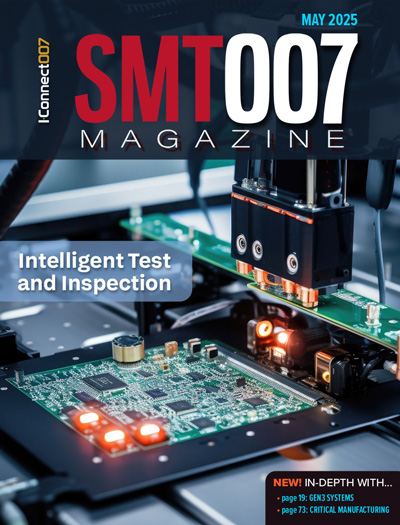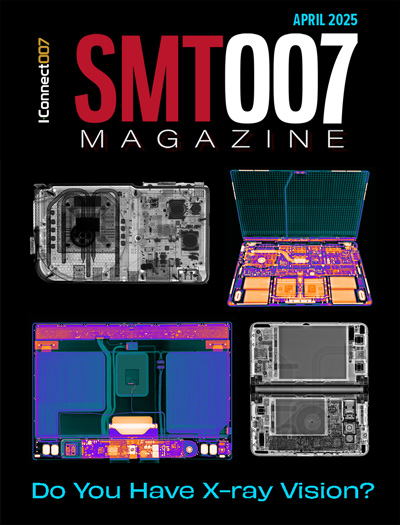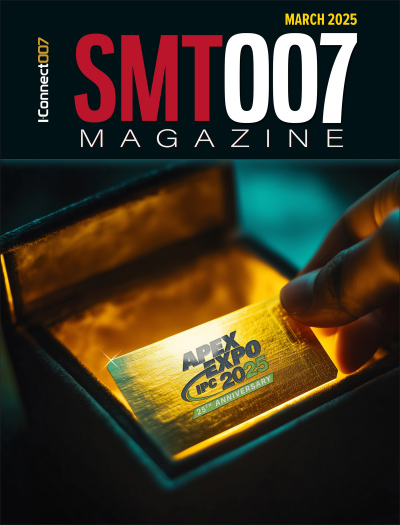-

-
News
News Highlights
- Books
Featured Books
- smt007 Magazine
Latest Issues
Current Issue
Intelligent Test and Inspection
Are you ready to explore the cutting-edge advancements shaping the electronics manufacturing industry? The May 2025 issue of SMT007 Magazine is packed with insights, innovations, and expert perspectives that you won’t want to miss.

Do You Have X-ray Vision?
Has X-ray’s time finally come in electronics manufacturing? Join us in this issue of SMT007 Magazine, where we answer this question and others to bring more efficiency to your bottom line.

IPC APEX EXPO 2025: A Preview
It’s that time again. If you’re going to Anaheim for IPC APEX EXPO 2025, we’ll see you there. In the meantime, consider this issue of SMT007 Magazine to be your golden ticket to planning the show.
- Articles
- Columns
Search Console
- Links
- Media kit
||| MENU - smt007 Magazine
Does China Plus One Actually Work?
December 10, 2024 | Manfred Huschka, Manfred Huschka Management Consulting (Shenzhen) Ltd.Estimated reading time: 2 minutes
Editor’s note: This is the first of a two-part series. Part one focuses on China.
We all know of the current geopolitical challenges between the U.S. and China, which have motivated companies to investigate shifting supply chains to other countries, including Vietnam, Thailand, Mexico, India, and Malaysia while continuing to source mainly from China. This strategy is being referred to as China Plus One. In this two-part article, I will summarize the current economic trends in China, and look at the trends in wider Southeast Asia.
Why China Plus One?
To understand China Plus One, we must start with the Entity List, which is a trade restriction list published by the U.S. Department of Commerce's Bureau of Industry and Security (BIS). It consists of certain foreign persons, entities, or governments that are subject to specific license requirements for the export, re-export, and/or transfer (in-country) of specified items. Approximately 600 Chinese entities are on that list (Huawei is one well-known example).
When an entity appears on the Entity List, U.S. companies must stop doing business with that entity immediately. Yet, one won’t know in advance which companies might get added or when. Since many Chinese state-owned companies are, by default, also engaged in some kind of military business, maintaining compliance is often quite difficult. Rather than going through a lengthy license application process which may result in a refusal, many OEMs and some of their direct suppliers, such as EMS companies, are looking to de-risk their business by diversifying their supply chain to include some non-China suppliers.
In addition, the supply chain issues during COVID-19 restrictions affected manufacturers and consumers worldwide—from the non-availability of loaded container ships out of China due to lockdowns (Shanghai, Ningbo-Zhoushan, and Shenzhen are three of the world’s top four container ports), to the overcrowding of container ships mainly outside of the Port of Los Angeles, where both chassis and truck drivers were in short supply at the port and empty containers could not get shipped back to China in a timely fashion.
In March 2021, the Ever Given, a container ship that ran aground in the Suez Canal, blocked the canal for six days. The canal is believed to handle about 10% of global commercial maritime traffic, linking Asia's factories to European customers. It is also a major conduit for oil.
All these events led to the emergence of China Plus One. While the reasons for de-risking the supply chain are understandable, this is not an easy task for several reasons, including the size of the sourcing company. The bigger the company, the bigger their leverage to take a new supplier on board or convince an existing supplier to build a factory outside of China.
In theory, everything sounds relatively easy: “Just find another supplier outside of China.” The reality looks completely different because the entire logistics process, including costs, must be considered.
To read this entire article, which appeared in the November 2024 issue of PCB007 Magazine, click here.
Suggested Items
U.S., China Announce New Trade Deal, Temporary Tariff Relief
05/12/2025 | IPCThe White House announced a new trade agreement with China on May 12 aimed at reducing trade tensions and providing temporary tariff relief for manufacturers.
Localized Automation Becomes a Tariff Storm Safe Haven, but U.S. Smart Factory Build-Out Costs Far Exceed China’s
05/09/2025 | TrendForceTrendForce’s latest “Human-Machine Technology Report” points out that although the 90-day delay on the U.S. reciprocal tariffs announced by the Trump administration in early April 2025 offers temporary relief, it has already triggered lasting shifts in global manufacturing and supply chain strategies.
Primech AI Plans Production of 300 HYTRON Robots through its China Manufacturing Expansion
05/09/2025 | Globe NewswirePrimech AI Pte. Ltd., a subsidiary of Primech Holdings Limited announced a significant expansion of its manufacturing capabilities through a strategic manufacturing partnership in Guangdong Province, China.
Choosing the Right Strategic Path
04/29/2025 | Marcy LaRont, PCB007 MagazineTom Yang, CEO of CEE PCB, discusses the current economic challenges, noting reduced purchasing power post-pandemic. He highlights the growing demand for HDI in consumer electronics due to AI growth. Tom also expresses concerns about tariffs under the new U.S. administration, prompting CEE to diversify production locations, including new plants in Southeast Asia. He emphasizes the need for PCB manufacturers to adapt strategically amidst rising costs and fierce competition, particularly for mid-sized shops facing unique challenges in the industry.
Linkage Technologies, Inc. Celebrates 10 Years of Excellence in PCB Solutions
04/22/2025 | Linkage Technologies, Inc.Linkage Technologies, Inc., a premier provider of printed circuit boards (PCBs) sourced from Asia, proudly marks its 10th anniversary, celebrating a decade of exceptional growth, unwavering commitment to quality, and dependable delivery.


